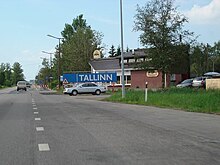Mõigu
Mõigu is a municipality ( Estonian asum ) of the Estonian capital Tallinn . The historical German name is Moik or Moick .
Location and history
The district is located in the south-east of the Kesklinn district ("city center") on the outskirts of the city, about five kilometers from Tallinn city center. Mõigu has 354 inhabitants (as of May 1st, 2010).
The settlements Mõigu and Järveküla were first mentioned in 1241 under the names Møickæ and Jærgækylæ . They were initially subordinate to the Tallinn Castle . In 1652 both were donated to the Tallinn Cathedral .
Moick Farm ( Mõigu mõis ) was founded between 1669 and 1683 . It was given to the Tallinn Cathedral in 1692 as a hospital gift.
In 1710 Mõigu and Järveküla were destroyed in the course of the Northern War . During the reconstruction, the Mõigu farm was moved to the Järveküla area. The village of Järveküla was newly established on the Mõigu courtyard. The rural population was resettled there and took the old place name with them. That is why the Mõigu manor is only a hundred meters away from Lake Ülemiste , while the Järveküla manor (literally “Seedorf”) is a few kilometers from the lake.
In the second half of the 18th century, the Russian tsarina Catherine II gave the Mõigu court to the (German-speaking) Tallinn cathedral parish. The restrained single-storey stone mansion was built around 1800. The house underwent extensive renovations in the 20th century and is now privately owned as a residential building. Most of the outbuildings are dilapidated or demolished. The former courtyard also includes a park that stretches to the shores of Lake Ülemiste.
Mõigu was an independent hamlet until the 1970s , when it was partially incorporated into the Tallinn City area. The other part fell to the village of Peetri ( Petrikülla ) in the rural community of Rae ( Johannishof ).
Mõigu Cemetery
The historic Baltic German cemetery of Mõigu ( Mõigu kalmistu ) was founded in 1774 by the (German-Baltic) parish of Tallinn Toompea . This was preceded by an ukase from the Russian Tsarina Catherine II of May 19, 1772, which forbade burial in churches and generally required burial in cemeteries outside the city limits. In addition to the lack of space in the crypts , this measure was intended to combat infectious diseases such as the plague .
Mainly wealthy citizens of Tallinn and Baltic German aristocrats were buried in the Mõigu cemetery. The grave chapel of the noble von Manteuffel family was of high artistic standard . At the cemetery were, among others, Paul Demetrius von Kotzebue 's daughter (1810-1884) and his wife Wilhelmine Elisabeth (1818-1902), Peter von Manteuffel (1768-1842), buried. Her daughter Olga Anna Pauline von Rosen (1842–1931) and her husband Konstantin Andreas Nikolaus von Rosen (1834–1915) also found their final resting place in Mõigu. Other celebrities included the Tallinn artist Karl Alexander von Winkler (1860-1911) and the doctor, mathematician, physicist and meteorologist Carl Ludwig Carpov († 1801).
The cemetery was completely destroyed and leveled by the Soviet occupation authorities in 1950/51 . The historical tombstones were used for construction work. The same measures of destruction directed against the legacy of the Baltic Germans in Estonia were applied to the Tallinn cemeteries of Kopli and Kalamaja .
literature
- Karl Laane: Tallinna kalmistud. , Tallinn 2002 ISBN 9985-64-168-X , pp. 67f.
Web links
- Mõigu Farm (Estonian)
Individual evidence
- ↑ Archived copy ( memento of the original from September 24, 2015 in the Internet Archive ) Info: The archive link was inserted automatically and has not yet been checked. Please check the original and archive link according to the instructions and then remove this notice.
- ↑ Baltic historical local dictionary. Part 1: Estonia (including Northern Livonia). Started by Hans Feldmann . Published by Heinz von zur Mühlen . Edited by Gertrud Westermann . Cologne, Vienna 1985 (= sources and studies on Baltic history. Volume 8/1), ISBN 3-412-07183-8 , p. 359.
Coordinates: 59 ° 24 ' N , 24 ° 49' E

